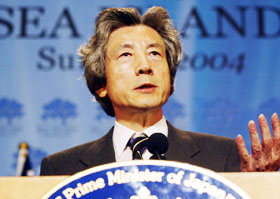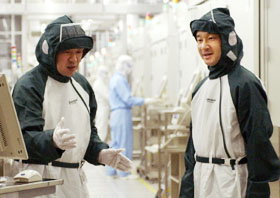
|

Japan's Prime Minister Junichiro Koizumi speaks to the media during a press conference at Sea
Island, Ga., on Thursday June 10, 2004, wrapping up his meetings with G8 leaders at the Sea
Island summit.
|
|
After a disastrous decade, markets, household spending, and once-struggling sectors are
soaring. Here's the story behind the numbers
One of the big surprises of the global economy is Japan's remarkable turnaround. It has
grown faster than the U.S. over the past six months, and its 3.2% expansion for the fiscal
year ended in March is the best showing the country has managed since 1996. The stock market
is up 45% over the past 13 months, and the economy is generating jobs again, pushing unemployment
to a three-year low of 4.7%. Exports -- always a strong driver of Japan's economy -- are soaring,
particularly to China. "Japan has not been this strong in the past decade," says General Electric
Co. (GE ) Chairman Jeffrey R. Immelt.
The surprise is that more and more of the recovery is being powered by demand at home, both
from business investment and consumer spending. On May 28, Japan reported that household spending
shot up 7.2% in April from the year-earlier period as shoppers flocked to department stores and
discounters, stocking up on everything from suits to stereos. You have to go back to the heady
days of 1982 to see that kind of consumer splurge in Japan.
This Japanese surge wasn't supposed to happen. After all, over the past decade a historic plunge
in stock and land prices, three recessions, and stagnant growth have wiped out as much wealth as
World War II did. Much of that was the wealth of a bubble economy -- unrealistic valuations
doomed to fall. The problem is that the authorities opted for a slow workout to avoid bankruptcies
and massive unemployment. That approach preserved social stability but cost trillions -- money
that could have been spent resurrecting the country more quickly -- and helped push Japan into
troublesome deflation. Even today the nation continues to experience major structural problems:
a still-fragile banking system, a central-government debt burden equal to 160% of gross domestic
product, and a sovereign credit rating more suited to a banana republic than to the world's
second-biggest economy. Nonetheless, Japan clearly is moving forward. Here's why:
Japan was written off as hopeless as recently as 18 months ago, but the numbers are finally looking
good. What's going on?
To understand the answer, you have to remember Japan in its heyday: Ever-higher exports to the
U.S. built up the strength of the keiretsu, those vast networks of corporations that supported
all members, no matter how weak. Meanwhile, high prices at home propped up domestic industries
and robbed the Japanese consumer of buying power. The system worked -- until the keiretsu banks
fueled a huge property bubble and gigantic overcapacity in the manufacturing sector. The banks
refused to cut off deadbeat borrowers, and recession set in. Not even continued U.S. demand
for Japanese products could end the downturn that started in 1993 and staggered on for nearly
a decade.
Today, though, Japan is a beneficiary of global trends that did not exist when it slid into
trouble. First, there's the rise of intra-Asian trade. A half-decade ago few understood how much
Japan would gain from China's boom. Chinese manufacturers and consumers have been eager buyers of
the machine tools, chipmaking equipment, cars, and consumer products that Japan excels at
making. Last year two-way trade with China shot up 30.4%, to $132.4 billion, for the first
time eclipsing import and export volumes with the U.S. And it's not just China: Southeast Asia
has also bounced back from the Asian financial crisis of 1997-98. Last year, Japanese exports
to Southeast Asia rose 10%, to $60 billion.
Japan is also raking in money from the growing global demand for must-have gadgets such as digital
cameras, flat-screen televisions, and DVD recorders -- products where it still has an edge. Fujitsu
Hitachi Plasma Display Ltd. and Matsushita Electric Industrial Co. (MI ) together control 42% of
the global market for plasma-display screens and are spending nearly $1 billion each to build
new factories in Japan. Meanwhile, Sony, Canon, and Olympus have a lock on half the global market
for digital cameras. The digital-appliance boom has in turn created business for Japanese
machine-tool companies that make specialized machinery needed to crank out microchips used in
these products. Machine-tool orders surged 25% in 2003, to $8.3 billion, government data show. Sure,
Japan faces competition from Korea, Taiwan, and China, but it leads in key technologies such as
tiny hard drives and specialized chips used in digital gizmos.
Tech isn't Japan's sole salvation. Something else happened, too, with little help from the
government of Prime Minister Junichiro Koizumi or any other politician: The mighty keiretsu
started to lose their iron grip on the economy. Constant deflation, heavy debt loads, and
stagnant demand at home chipped away at corporate profits, forcing the weakest into
bankruptcy. The tight relationships among banks and borrowers, manufacturers and suppliers
started to fray. To survive, the strongest companies went offshore to produce their goods
and ship them back to Japan at ever-lower prices.
At the same time, Japan's consumer psychology started to change, and deflation, ruinous as
it was, proved to have a hidden payoff. Shoppers demanded lower prices and got them -- from
entirely new retail categories such as "100 yen" shops, discount grocers, and warehouse-style
department stores offering more and cheaper imported goods. So Japan's hard-pressed consumers
finally could stretch their spending power, even on scantier wages. With employment picking up
and strong economic growth, many now have the best of both worlds: steady incomes and still-decent
prices.
Global investors are starting to amplify these trends. Until the mid-1990s about half of equities
in Japan were held by banks, a legacy of the keiretsu cross-shareholding networks. That figure
is now about 25%, according to fund manager Sparx Asset Management. The banks sold off
their shares in 2001 and 2002 to meet new capital requirements imposed by regulators. Those
sales sent the Nikkei 225 stock index to 20-year lows 13 months ago. But the sell-off sparked
interest in Japanese stocks among foreign investors, who poured $77 billion into Japanese
equities last year and now control 30% of the shares traded on the Tokyo bourse.
Those foreign shareholders are demanding better corporate governance, profitability, and
transparency. In December, for instance, private equity fund Steel Partners Japan Strategies

|

Aya Yanai of Fuji Film shows Fuji's new digital camera lineup FinePix Square Mini F450, left, and
F440 at the firm's unveiling of the products in Tokyo, Thursday, June 17, 2004. The new lineup
improved its overall operational specifications with smaller in sizecompare to the current
lineup. F450 and F440 models capture all images with resolution of 5.2 megapixel and 4.1
megapixel respectively and will be on market July 2004.
|
|
LP launched a hostile takeover of Yushiro Chemical Industry Co. Why? Steel Partners, which owned
8.9% of the cash-rich machine-oil maker, was tired of the company's low stock price and paltry
dividend. Yushiro fended off the attack, but not before a panicked management agreed to raise
its dividend fourteen-fold. Meanwhile, dealmaker Wilbur L. Ross Jr. has established a $200
million fund with the California Public Employees' Retirement System pension fund that will
buy japanese shares and agitate for better governance. American private equity players are
at work, too. Carlyle Group and Lone Star are on the prowl for turnaround opportunities
after seeing the success Ripplewood Holdings had with its investments in Japan Telecom
and the near-bankrupt long term credit bank, now called Shinsei.
Isn't too much of Japan's recovery linked to the volatile, overheated China trade?
That's a legitimate worry. "Japan's reflation is just the mirror image of China's investment
cycle overshooting," says Hong Kong-based Morgan Stanley (MWD ) economist Andy Xie. Regarded
as a China bear, Xie thinks the good times will be short-lived. The bubble in China has sparked
a capital-expenditure turnaround in Japan, he says, and that has fed into the rebound in consumer
spending. Once China collapses, Xie says, Japan's economy will suffer heavy collateral damage.
The argument, though, may be overblown. Few think the long-term outlook for China is anything
but rosy, and there are some signs that the country is headed for a soft landing. Unless the
U.S. were to crash at the same time, it's hard to imagine Japan falling back into
recession. Moreover, such reasoning ignores the fact that, while Japanese companies have rushed
to build up Chinese plant capacity to sell goods to consumers there, they're also using China as
a cheap production base to sell products back home and around the world. Imports from China shot
up 21.9%, to $75 billion, in 2003. About 15% of that, says the Japan External Trade
Organization, was "reverse imports" -- subsidiaries of Japanese companies sending Chinese-made
PCs, printers, and DVD players back home. China may see boom-and-bust periods that crimp
Japanese export growth, but Corporate Japan still benefits from having a vast production base
on the mainland.
It's also hard to argue that China has much to do with the rapacious domestic demand for digital
appliances. The boom started inside Japan about two years ago; today roughly half of all Japanese

|

Japanese Crown Prince Naruhito, right, in anti-dust suit, listens to a staff of semiconductor
manufacturer Trecenti Technologies Inc., at its factory in Hitachinaka, north of Tokyo,
Thursday, June 17, 2004. Crown Prince Naruhito inspected the production process of its
LSIs and sophisticated microcomputers used for digital cameras and cell phones.
|
|
households have digital cameras, and one-third own DVD players. If you have ever visited a
space-starved Japanese home, you can quickly grasp why sleek flat-screen TVs are all the rage. In
March, Japanese consumers bought 216,000 of them, up 72% year-on-year. Now that these products have
been successfully marketed at home, companies are boosting capacity to sell more overseas. Matsushita
just announced plans for a new factory to crank out 3 million plasma-display panels a year. When it
comes to digital TVs, says Fumio Ohtsubo, a senior managing director with Matsushita, "we can't be
beaten."
Has Japan Inc. really restructured enough to regain its global stature?
It depends on which part of Japan Inc. you're talking about. There has been a true revival in the
competitiveness of the biggest multinationals, particularly in electronics, steel, and autos. Nissan
Motor Co. (NSANY ), for instance, had a near-death experience but was revived by foreign capital
and world-class managers such as CEO Carlos Ghosn. Today, Nissan is enjoying record profits. Ghosn
sees enormous potential in Japan given its educated and diligent workforce, engineering smarts,
and manufacturing prowess. "Every problem has a solution," he says. "The key is getting people
thrilled about what's going on in the company."
Other Japanese outfits have relied on homegrown managerial talent to pull out of the rut. At
Matsushita, CEO Kunio Nakamura has closed or streamlined dozens of plants, cut the workforce by 20%
since 2000, and last year poured some $5.5 billion into research and development on products such as

|

Japanese children enjoy a brief metamorphosis to Buzz Lightyer as a special parade, titled
"Buzz Lightyear's Big Mission, " featuring the character from Disney/Pixar's "Toy Story"
film kicks off at Tokyo Disneyland in Urayasu, east of Tokyo, Monday, June 14, 2004. The summer
attraction, in which Buzz Lightyear and other Disney characters spray water on spectators,
would cool off the theme park visitors until the end of August.
|
|
camera phones and flat-screen TVs. Even Old-Economy mainstays are getting into the act. Toray
Industries Inc., a manufacturer of synthetic fibers, now produces materials needed for making
LCD panels. And steelmaker JFE Holdings Inc. has stormed back to profitability with decisive
downsizing and a shift to higher-margin products such as sheet metal for carmakers. All in all,
the average return on equity of Japan's 400 top nonfinancial companies has jumped fourfold, to
7%, since 1998. Goldman, Sachs & Co. (GS ) thinks it could hit 10% by 2006. Another new trend
is part-time employment, which adds to companies' operating flexibility. Last year the number
of temps soared 21.8%, to 2.13 million workers -- 2 1/2 times as many as five years ago, or
3.5% of the workforce.
That said, there are still plenty of backward-looking companies. While labor productivity increased
about 2% overall in 2003, the biggest gains came from giants such as Toyota and Canon. Companies in
services, retail, construction, and food processing -- which represent some 60% of total employment
-- lag far behind, says Nikko Citigroup Ltd. (C ) economist Jeffrey Young. "In some cases,
productivity is falling outright," he points out. That lack of productivity translates to
scarce profits. In the past fiscal year the five most profitable enterprises represented
some 25% of the pretax earnings of Japan's 300 biggest companies, Young says. So while Japan
has made progress, its restructuring drive still needs to go deeper.
The banking sector seems to be bouncing back. Will that make much of a difference?
This is one area where Koizumi deserves credit for getting the job done. His appointment of Heizo
Takenaka as Japan's economics czar and top bank regulator was smart. Takenaka and his staff at
the Financial Services Agency have forced Japanese bankers to reclassify marginal loans as the
duds that they really are and made them drop accounting gimmicks that hide problems. For instance,
in March, FSA auditors discovered that banking group UFJ Holdings Inc. had underreported loans by
some $9.1 billion and needed to shore up reserves by $8.4 billion. UFJ reported a $3.6 billion
loss last year -- a shock, but a refreshing change after years of book-doctoring with tacit
government permission.
The other side of the bank problem is that many companies that were going to go under have already
gone bankrupt, while borderline cases have returned to health as the economy improved. Last year,
the number of corporate bankruptcies fell by 16.6%. The banks have written off much of the debt
owed by those companies or sold it to a government loan-workout corporation. So the level of
nonperforming loans at major Japanese banks has dropped by about half over the past two years,
to $124 billion, or about 5% of their loan books. This development could prove a tremendous
boost for the economy. With the banking sector in a funk, total outstanding loans have been
declining for the past six years, hobbling the ability of enterprises to raise capital for
expansion. True, the rebound in the Nikkei has reopened a key source of financing, and the
best-run companies have no problem raising money in global markets. Still, Japan needs a
vibrant banking sector to fund new ideas.
What are the challenges for Japan now?
Japan still suffers from deflation, which took root in 1998. Consumer prices have been dropping at
about 1% annually, and land prices have fallen since 1992. Most economists, though, think prices are
hitting bottom and will start rising modestly late next year.
The government also faces a Godzilla-sized debt problem. Its national pension scheme is such a mess
that most workers -- and even some politicians -- don't even bother to pay into it. These troubles
are fixable provided Japan keeps growing and Koizumi can push through higher pension premiums and
rein in government spending. But it will take years, if not decades.
Then there's the question of when the Bank of Japan will boost its benchmark interest rate from the
near-zero level it has maintained since 1999. BOJ Governor Toshihiko Fukui probably won't move until
consumer prices start to rise next year, and even then will only raise rates modestly. That shouldn'
t hurt. But if inflation sets in, he may have to be more aggressive. Then the government's debt
costs would rise, which in turn could make it harder to reduce the deficit and cut spending.
For now, though, ordinary Japanese finally have a reason for cautious optimism. Kimiko Hasegawa, 50,
recently spent an afternoon looking through designer dresses at the upscale Mitsukoshi department
store in the Ginza, for the first time in ages. "For the past two years, I only shopped at
discounters," she says. If Japan can keep growing and get its competitive groove back, more
and more Japanese might feel confident enough about their economic future to splurge. For the
world economy, that could be a very good thing.

